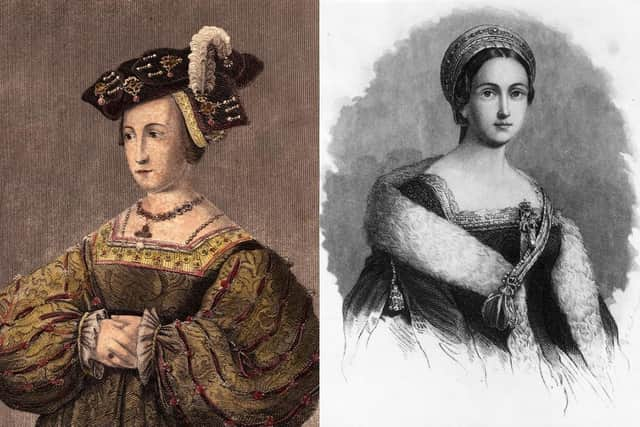Who was Anne Boleyn? Why was she executed by Henry VIII – and secret notes found in her prayer book explained
Hidden names in the prayer book of Anne Boleyn the second wife of King Henry VII, have been discovered by researcher Kate McCafferty, which unveils the mystery behind how the book managed to survive after Boleyn’s death.
But who was the former Queen of England, and why did King Henry have her executed?
This is everything you need to know about Anne Boleyn.


Who was Anne Boleyn?
Advertisement
Hide AdAdvertisement
Hide AdAnne Boleyn was the second wife of King Henry VIII of England, and the mother of Queen Elizabeth I.
She was born sometime around 1501, and she spent her childhood at Hever Castle in Kent.
In 1526, King Henry’s interest in Boleyn significantly increased. His long term marriage with Katherine of Aragon had produced only one child - a daughter, Princess Mary. By the mid-1520’s, King Henry was becoming desperate for a male heir to secure the future of the Tudor dynasty.
However, in the Tudor period, Historic Royal Palaces (HRP) explains, “not even a King could simply decide to get a divorce”.
In 1527, the King began searching for a way to dissolve his marriage to Katherine of Aragon, even going so far as to tell the Pope that the marriage had never been legitimate because “he had sinned in taking his brother’s widow, which some scholars believed to be prohibited by the Bible”, HRP says.
While the Pope refused to bend to King Henry’s demands, a book called Obedience of a Christian Man by William Tyndale argued that supreme authority is not held by the Pope, but instead by the words of God that are in the Bible.
In 1531, King Henry defied the Pope and dismissed Katherine - he and Boleyn were married in January 1533, and she was crowned Queen in Westminster Hall on 1 June that same year.
When was she executed?
Advertisement
Hide AdAdvertisement
Hide AdBolyn was executed on 19 May 1536. Following a miscarriage on 1534 and a stillbirth in 1536, and King Henry’s growing interest in Jane Seymour, King Henry had her comitted to the Tower of London on 2 May 1536 on charges of treason, adultery and incest.
Boleyn was convicted unanimously and was beheaded on 19 May 1536. Less than two weeks later, King Henry remarried with Seymour.
HRP explains that “unbiased descriptions of Anne are difficult to find” as most were written after her death.
HRP says: “Anne was effectively written out of the history books for the rest of Henry VIII’s reign, and that of his son, Edward VI.
“Her name was literally chiselled out of Hampton Court, her badges and heraldry replaced by those of Jane Seymour.”
The final resting place of Boleyn is the Chapel Royal of St Peter ad Vincula at the Tower of London, where she is buried.
What are the secret inscriptions?
The mystery of what happened to Boleyn’s prayer book after her death has been revealed by a study conducted by Kate McCafferty.
Advertisement
Hide AdAdvertisement
Hide AdThe book, which has been on display in her childhood home of Hever Castle in Kent, is believed to have survived by being passed down through a network of family and friends.
On the anniversary of Boleyn’s execution, Hever Castle announced that the research, conducted by McCafferty, a former Hever Castle stewart, has uncovered never seen before names and words hidden in the pages of the historic Book of Hours volume.
McCafferty spent a year studying the two prayer books as part of her master’s degree for her thesis in Medieval and Early Modern Studies at the University of Kent, and discovered new wording in the printed Book of Hours, which had been left undiscovered for hundreds of years.
Despite the pressure to remove all items belonging to the former Queen after her death, the prayer book she is believed to have taken to her execution still survives to this day.
By using ultraviolet light and photo editing software, McCafferty found three family names written in the book: Gage, West and Shirley (from Sundridge, near Sevenoaks). These three names centre around a fourth, the Guildford family of Cranbrook in Kent.
This research uncovered that the book was passed from female to female of families not only local to the Boleyn family at Hever, but also connected by kin.
McCafferty said: “It is clear that this book was passed between a network of trusted connections, from daughter to mother, from sister to niece.
Advertisement
Hide AdAdvertisement
Hide Ad“If the book had fallen into other hands, questions almost certainly would have been raised over the remaining presence of Anne’s signature. Instead, the book was passed carefully between a group of primarily women who were both entrusted to guard Anne’s note and encouraged to add their own.
“In a world with very limited opportunities for women to engage with religion and literature, the simple act of marking this Hours and keeping the secret of its most famous user, was one small way to generate a sense of community and expression.”
McCafferty added: “It was incredibly exciting and surreal to uncover these erased inscriptions, and it has been an absolute privilege to restore the names of their authors and recover their stories. What is perhaps most remarkable is that these inscriptions have been unknown and unstudied for so long.”
